NASA, Civil Space Shortfall Ranking, space technology, lunar night survival, space exploration, space missions, technology development, space science, NASA STMD, aerospace industry
Discover NASA’s groundbreaking 2024 Civil Space Shortfall Ranking, highlighting the top technological challenges in space exploration. Learn about the most critical areas requiring development to ensure future mission success and scientific breakthroughs. Join the community in addressing these challenges to pave the way for new discoveries and economic opportunities.

NASA Releases First Integrated Ranking of Civil Space Challenges
In a groundbreaking move, NASA has unveiled a comprehensive document that highlights nearly 200 technology areas requiring further development to meet future exploration, science, and mission needs. This document, published in the spring, represents an extensive effort by NASA to involve the aerospace community in prioritizing these challenges. By inviting the community to rate the importance of these areas, NASA aims to better integrate and address the most critical technical shortfalls, guiding its space technology development and investment strategies.
The 2024 Civil Space Shortfall Ranking Document
The Space Technology Mission Directorate (STMD) of NASA has released the 2024 Civil Space Shortfall Ranking document, which integrates inputs from a wide array of stakeholders. These stakeholders include NASA mission directorates and centers, small and large industry organizations, government agencies, academia, and other interested individuals. The integrated list, which will be updated annually, will serve as one of many factors guiding NASA’s technology development projects and investments.
“Identifying consensus among challenges across the aerospace industry will help us find solutions, together,” said NASA Associate Administrator Jim Free. “This is the groundwork for strengthening the nation’s technological capabilities to pave the way for new discoveries, economic opportunities, and scientific breakthroughs that benefit humanity.”
Top Priorities in Space Technology
The document highlights strong stakeholder agreement on the 30 most important shortfalls. Leading the list is the challenge of surviving and operating through the lunar night. The significant and sustained temperature drops during the lunar night pose serious difficulties for running science experiments, rovers, habitats, and other equipment. Potential solution technologies include new power, thermal management, and motor systems.
Second and third on the integrated list are the needs for high-power energy generation on the Moon and Mars and high-performance spaceflight computing. Other highly rated capability areas in the top 20 include advanced habitation systems, autonomous systems and robotics, communications and navigation, power, avionics, and nuclear propulsion.
Strategic Investments and Future Technologies
The diversity and interdependence of the shortfalls emphasize the need for strategic investments across multiple areas. This approach is crucial for maintaining U.S. leadership in space technology and driving economic growth. STMD is currently evaluating its existing technology development efforts against the integrated list to identify potential adjustments within its portfolio.
“This effort is an excellent example of our directorates working together to assess future architecture needs that will enable exploration and science for decades to come,” said Nujoud Merancy, deputy associate administrator for the Strategy and Architecture Office within NASA’s Exploration Systems Development Mission Directorate.
Community Involvement and Response
The 2024 results are based on 1,231 total responses, including 769 internal and 462 external responses. Twenty of these were consolidated responses representing multiple individuals from the same organization. Once average shortfall scores were calculated for each organization, STMD grouped, totaled, and averaged scores for nine stakeholder groups. Pre-determined weights were then applied to each group to create the overall ranking. NASA also published the ranked results for each stakeholder group based on the 2024 feedback.
Future Insights and Developments
The rankings are based on the numerical scores received and not responses to the open-ended questions. However, NASA anticipates that the qualitative feedback will uncover additional insights. These insights could potentially lead to further refinements and enhancements in addressing the identified challenges.
To facilitate a deeper understanding of the ranking process and results, NASA will host a webinar on July 26, 2024, at 2 p.m. EDT. This webinar will provide an overview of the methodology and findings, offering participants an opportunity to engage with NASA officials and gain a clearer perspective on the future of space technology development.
The Importance of Community Consensus
The integrated results from this comprehensive ranking document reflect a broad consensus across the aerospace industry. This consensus is vital for identifying and addressing the most pressing technical challenges. By leveraging the collective expertise and insights of the community, NASA aims to develop innovative solutions that will pave the way for new discoveries, economic opportunities, and scientific breakthroughs that benefit humanity.
Conclusion
NASA’s release of the first integrated ranking of civil space challenges marks a significant step forward in the agency’s efforts to address the most critical technology areas for future exploration and mission success. The 2024 Civil Space Shortfall Ranking document, developed with extensive input from the aerospace community, provides a roadmap for strategic investments and technology development. As NASA continues to evaluate and adjust its technology portfolio based on these rankings, the agency is poised to strengthen its technological capabilities, drive economic growth, and achieve groundbreaking scientific discoveries. The upcoming webinar on July 26, 2024, will offer further insights into the ranking process and the future of space technology development, underscoring NASA’s commitment to collaboration and innovation in the pursuit of space exploration excellence.
Read More
- How Climate Change is Shifting Earths Rotation: Insights from NASA Studies
- DALL-E 2 Review: Everything You Need To Know
- NASA GOLD Mission Discovers Surprising Alphabetical Shapes in Earth’s Ionosphere
- NASA Issues Warning About 88-ft Airplane-Sized Asteroid Approaching Earth – Key Details Revealed










